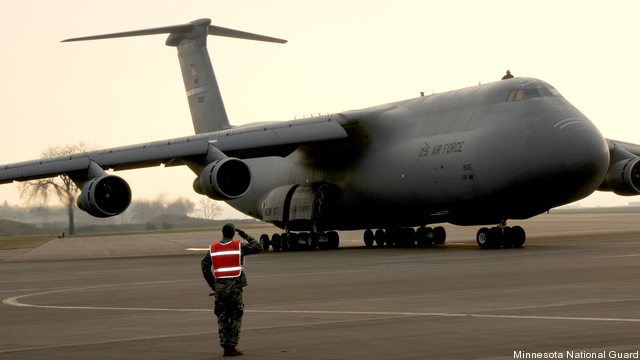Pentagon Searching For New Ways To Move Gear During Next War
Posted on
WASHINGTON: The Pentagon is growing increasingly concerned that rival powers could block the resupply and reinforcement of its troops in upcoming conflicts by using new generations of missiles and advances in air and sea power, or cyber hacks that shut down unsecured networks.
The past two decades of war in the Middle East and Afghanistan have seen military leaders simply turn on the spigot to pump mountains of supplies into combat zones. With no air or sea threats to slow them down, the gear has been delivered when and where needed by an army of civilian contractors. But those days are over, Pentagon leaders say, as Chinese and Russian cyber attacks, advanced aircraft and long-range missiles can effectively shut the door on resupply, or at least make US forces pay a heavy price for attempting to move material.
In December 2016, the head of Pentagon acquisition Frank Kendall signed a memo creating a “Survivable Logistics” task force led by the Defense Science Board with the marching orders to take a hard look at the problem. The work, being led by business leaders and several retired 3 and 4 star generals, should wrap up in the coming months, and has become something the Trump White House has taken an interest in, according to one source.
Kendall told me recently that the concerns about Russia and China aren’t new (he’s right — Air Force Secretary Deborah Lee James, Air Force Secretary under Obama, was the first senior official to declare what we could call Cold War 2.0 by naming Russia as our greatest threat). There has been concern about the US posture overseas for some time. He said he was “interested in doing a lot more work in general on sustainment,” on the future battlefield, while getting military planners to take a harder look at how technologies were being used in commercial logistics to move people and goods around the globe, quickly.
“I was concerned that we were not moving aggressively enough to use advanced technologies in our own operations,” Kendall said.
There was talk in the closing days of Ash Carter’s Pentagon of kicking off a Better Buying Power-type program focused on sustainment, Kendall said, but the building was running up against the 2016 presidential election, and he and other senior officials decided not to launch a new program that would require major changes in spending, and relationships with contractors, just before the change in administrations.
The memo that Kendall signed, however, takes a clear-eyed look at what the US military might face in any future conflict with a peer adversary where speed and maneuver will be the key. “Some operations will have no secure rear areas from which to provide logistics support,” the memo states. “In addition support may have to be provided closer to the areas of active combat and on a much more distributed and disaggregated basis.”
This would be true of any conflict with China in the South China Sea, in which US bases in Japan, Guam and Okinawa would be in range of Chinese aircraft and missiles, or in the Baltics, where Russian submarines, and its exclave of Kaliningrad, could strike fast and deep within the NATO alliance.
The Air Force is already looking at agile basing possibilities in the Pacific, including putting equipment in the Mariana Islands and the Philippines. The idea is, “instead of having 100 airplanes at Kadena, you have planes spread out over different locations,” said David Ochmanek, a researcher at the RAND Corporation who focuses on force planning.
But simply dispersing air squadrons or Marine units doesn’t necessarily make life easier. “When you look at the tonnage it takes to sustain airborne operations, feeding that machine is hard enough,” said Ochmanek — who served as deputy assistant secretary of Defense for force development — “but feeding it when you’re in contested operations is an order of magnitude more difficult.”
The work is ongoing. The Defense Science Board has put together a 16-member Survivable Logistics task force of CEOs and retired 3- and 4-star officers. It’s chaired by two retired generals, Paul Kern and Duncan McNabb. According to Pentagon spokesperson Lt. Col. Michelle Baldanza, the group is currently drafting a final, classified report. An unclassified executive summary will be publicly available “in the next few months.”
It’s not clear what kind of weight the report will carry once it’s finished. But with the White House paying attention, and the team surrounding Defense Secretary James Mattis squarely focused on the threats posed by peer competitors like China and Russia, the subject matter adds another data point to work already being done elsewhere in the building.
The dangers posed by stealth aircraft, anti-aircraft batteries and hypersonic missiles are one thing, but the instructions given to the task force also focus on threats in the cyber realm.
Air Force Gen. Darren McDew, then-chief of U.S. Transportation Command, warned Congress in April that the Pentagon’s heavy reliance on contractors has led to a situation where a full 90 percent of military logistics planning takes place on unclassified commercial networks that is out of his control, and which remain vulnerable to hacking.
His successor, Army Gen. Stephen Lyons, hold a Senate panel in June that “the cyber vulnerabilities we see today are a significant threat to our strategic logistics, and frankly, our national security.”
Transportation Command has moved its data to the cloud, and is partnering with the Defense Innovation Unit (DIUx), the Defense Digital Services and the Strategic Capabilities Office to build a “data lake” for logistical command, control and intelligence.
Those moves are precursors to the command relying more on Machine Learning, Artificial Intelligence and autonomy in the coming years, McDew said, including “trucks that drive themselves, ships that can navigate oceans without human inputs, and wide-body aircraft that can land on their own.”
While unmanned and autonomous aircraft and ships would undoubtedly save lives in a fight against rival powers, they can still be sunk or knocked out of the sky, leaving air wings and ground troops in the lurch. After 17 years of fighting wars from safe and static bases stocked with ammo and warehouses full of food — with total control over the skies — the Pentagon is scrambling for a new way to ship guns and butter.
Subscribe to our newsletter
Promotions, new products and sales. Directly to your inbox.



